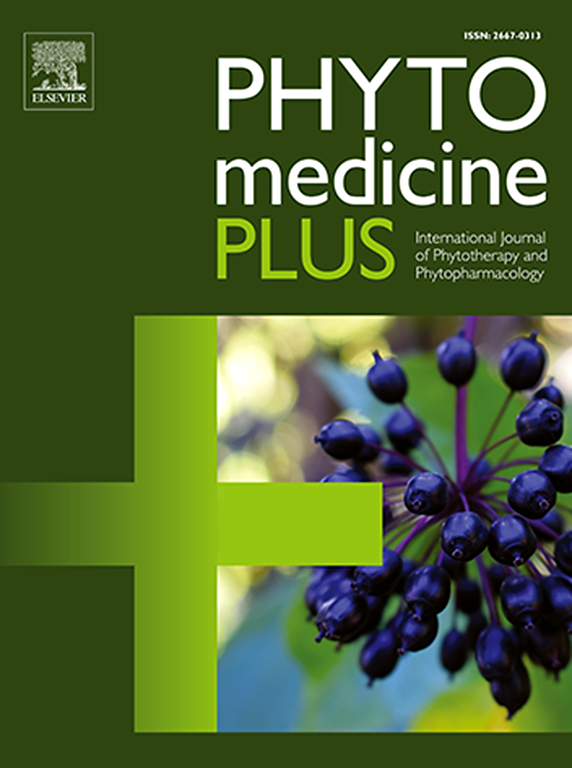评估一种多成分泰国草药配方的抗氧化和抗炎特性、生物活性化合物特征和分子机制
Q3 Pharmacology, Toxicology and Pharmaceutics
引用次数: 0
摘要
背景长期以来,人们一直将药用植物用作膳食补充剂,以降低慢性疾病、炎症、癌症和代谢综合征的风险。本研究旨在评估 Belog Plus(BP)的功效,这是一种含有五种泰国药用植物的多草药产品:Belog Plus(BP)是一种多草药产品,含有五种泰国药用植物:枳壳、大麻、三棱草、高良姜和胡椒,并与红花籽油结合使用。这项研究的重点是量化总酚含量(TPC)和总黄酮含量(TFC),并确定有助于其治疗特性的关键草药生物标志物。除了评估植物提取物的抗氧化和抗炎潜力外,该研究还探索了其抗炎活性的分子机制,从而全面了解了 BP 的功效。方法使用 DPPH、FRAP 和 H2O2 诱导的氧化应激评估 BP 的乙醇提取物及其成分的抗氧化潜力。抗炎活性采用 Griess 反应测定法进行评估,其机制则通过 mRNA 和蛋白质表达分析进行探讨。结果结果表明,BP 的乙醇提取物(6.25-100 µg/ml)通过抑制一氧化氮(IC50 24.4 μg/ml)和显著降低炎症基因 iNOS、COX-2、IL-6 和 TNF-α 的表达,表现出强大的抗炎作用。此外,在浓度为 6.25-25 µg/ml 时,它还能明显降低炎症蛋白 iNOS 和 COX-2 的表达。在单个成分中,C. aurantifolia、A. galanga 和 P. nigrum 具有很强的抗炎作用,IC50 值分别为 35.7、6.5 和 23.3 μg/ml。TPC 和 TFC 结果表明,酚类(80.6 µg GAE/mg)和类黄酮(47.4 µg 儿茶素/mg)化合物的含量很高。此外,LC-MS/MS 分析还发现了多种具有抗炎特性的生物活性化合物。本文章由计算机程序翻译,如有差异,请以英文原文为准。
Evaluation of antioxidant and anti-inflammatory properties, bioactive compound profiling, and molecular mechanisms of a multicomponent Thai herbal formulation
Background
Medicinal plants have long been used as dietary supplements to reduce the risk of chronic diseases, inflammation, cancer, and metabolic syndromes. Traditional remedies possess therapeutic properties, making them promising candidates for further investigation and potential pharmaceutical development.
Aim of the study
This study aimed to evaluate the efficacy of Belog Plus (BP), a polyherbal product containing five Thai medicinal plants: Citrus aurantifolia, Cannabis sativa, Tiliacora triandra, Alpinia galanga, and Piper nigrum, combined with safflower seed oil. This study focused on quantifying the total phenolic content (TPC) and total flavonoid content (TFC), and identifying key herbal biomarkers that contribute to its therapeutic properties. In addition to assessing the antioxidant and anti-inflammatory potential of the plant extracts, the study explored the molecular mechanisms underlying their anti-inflammatory activity, offering a comprehensive understanding of BP's efficacy.
Methods
The ethanolic extract of BP and its components were assessed for antioxidant potential using DPPH, FRAP, and H2O2 induced oxidative stress. The anti-inflammatory activity was evaluated using the Griess reaction assay, and the mechanisms were explored through mRNA and protein expression analysis. The TPC and TFC were measured using the Folin–Ciocalteu (F–C) assay and the aluminium chloride colorimetric assay, respectively, while herbal biomarkers were identified using LC-MS/MS analysis.
Results
The results revealed that the ethanolic extract of BP (6.25–100 µg/ml) exhibited a potent anti-inflammatory effect through nitric oxide inhibition (IC50 24.4 μg/ml) and significantly reducing the expression of inflammatory genes iNOS, COX-2, IL-6, and TNF-α. Additionally, it significantly reduced the expression of inflammatory proteins iNOS and COX-2 at concentrations of 6.25–25 µg/ml. Among the individual components, C. aurantifolia, A. galanga, and P. nigrum showed potent anti-inflammatory effects with IC50 values of 35.7, 6.5, and 23.3 μg/ml, respectively. The TPC and TFC results demonstrated significant levels of phenolic (80.6 µg GAE/mg) and flavonoid (47.4 µg catechin/mg) compounds. Additionally, the LC-MS/MS analysis identified a variety of bioactive compounds known for their anti-inflammatory properties.
Conclusion
These findings support BP's potential use as a dietary supplement to mitigate the risk of chronic inflammatory diseases, with its ethanolic extract containing bioactive phenolic and flavonoid compounds that significantly suppress iNOS and COX-2 protein expressions.
求助全文
通过发布文献求助,成功后即可免费获取论文全文。
去求助
来源期刊

Phytomedicine Plus
Medicine-Complementary and Alternative Medicine
CiteScore
3.70
自引率
0.00%
发文量
178
审稿时长
81 days
期刊介绍:
 求助内容:
求助内容: 应助结果提醒方式:
应助结果提醒方式:


